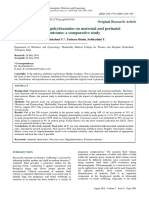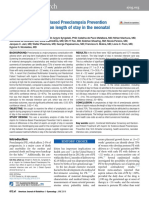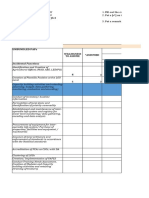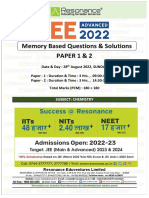Evaluation The Effect of Low Dose Aspirin On Endothelial Dysfunction in Preeclamptic Patients
Evaluation The Effect of Low Dose Aspirin On Endothelial Dysfunction in Preeclamptic Patients
Uploaded by
AbrahamisnanCopyright:
Available Formats
Evaluation The Effect of Low Dose Aspirin On Endothelial Dysfunction in Preeclamptic Patients
Evaluation The Effect of Low Dose Aspirin On Endothelial Dysfunction in Preeclamptic Patients
Uploaded by
AbrahamisnanOriginal Title
Copyright
Available Formats
Share this document
Did you find this document useful?
Is this content inappropriate?
Copyright:
Available Formats
Evaluation The Effect of Low Dose Aspirin On Endothelial Dysfunction in Preeclamptic Patients
Evaluation The Effect of Low Dose Aspirin On Endothelial Dysfunction in Preeclamptic Patients
Uploaded by
AbrahamisnanCopyright:
Available Formats
[Downloaded free from http://www.jmsjournal.net on Tuesday, May 29, 2018, IP: 103.78.96.
21]
Original Article
Evaluation the effect of low‑dose aspirin on
endothelial dysfunction in preeclamptic patients
Mohammad Hashemi, Forouz Baktash1, Kiyan Heshmat‑Ghahdarijani, Elahe Zarean1, Saeide Bahrani
Department of Cardiology, School of Medicine, Medical Students’ Research Committee, 1Department of Obstetrics and Gynecology, School of
Medicine, Isfahan University of Medical Sciences, Isfahan, Iran
Background: Preeclampsia complicates up to 3% of pregnancies in developing countries. Endothelial dysfunction plays an important
role in pathogenesis of preeclampsia. In this study, we aim to evaluate the effect of low‑dose aspirin on endothelial dysfunction in
preeclamptic patients. Materials and Methods: in this triple‑blind randomized clinical trial, enrolled patients were divided randomly
into two groups. Acetylsalicylic acid (ASA) 80 mg or placebo will be taken daily by oral administration from the initiation of diagnosis
until 2 months after delivery. Every patient’s flow‑mediated dilation (FMD) were evaluated at the beginning of study and 2 months
after delivery with the same experienced operator at a same period of the time (3–5 pm) by high‑resolution B‑mode ultrasonographic.
T‑test or Mann–Whitney test was used in the comparison of means between the intervention and placebo groups. To compare FMD
in each group, before and after the intervention, paired t‑test was used. Results: Mean value of FMD in intervention (9.61 ± 5.58)
and control group (9.40 ± 4.33) have no significant differences before drug consumption (P = 0.089). FMD in intervention group
significantly increased after ASA consumption ([9.61 ± 5.58 vs. 13.65 ± 7.91] [P = 0.044]). Conclusion: Increase mean of FMD in
intervention group shows that this supplement can improve endothelial function.
Key words: Acetylsalicylic acid, endothelial dysfunction, preeclampsia
How to cite this article: Hashemi M, Baktash F, Heshmat‑Ghahdarijani K, Zarean E, Bahrani S. Evaluation the effect of low‑dose aspirin on endothelial
dysfunction in preeclamptic patients. J Res Med Sci 2016;21:128.
INTRODUCTION are predisposed to for cardiovascular diseases due to
endothelial dysfunction may be persistent after delivery.
Endothelial dysfunction causes different disorders in
human body including preeclampsia during pregnancy. Several studies reported the role of endothelial cells in
The pathogenesis may be due to inflammatory endothelial‑dependent diseases including preeclampsia
responses that trigger pregnancy‑induced hypertension and it is recently proved that endothelial dysfunction
consequently. This condition increases burden of disease plays an important role in pathogenesis of preeclampsia.
in developed and developing countries. Preeclampsia The endothelial function should be evaluated by
complicates up to 5–10 and 3% of pregnancies in measuring brachial artery flow‑mediated dilation (FMD)
developed and developing countries, respectively.[1‑3] by high‑resolution B‑mode ultrasonography after
The prevalence of preeclampsia is 3% in Iran. In addition, triggering shear stress. Bujold et al. reported that
eclampsia happens in 0.1% of pregnancies in Iran.[4] It low‑dose aspirin, as an antiplatelet, in early pregnancy
plays an important role in occurring prenatal and decrease the risk of preeclampsia and intrauterine
perinatal events including premature delivery, severe growth retardation (IUGR).[5] Another study represented
hypertension, increasing the risk of stroke, maternal that low‑dose aspirin decreases the risk of preeclampsia
death. Mothers with the medical history of preeclampsia in healthy nulipar pregnant women but has no impact on
prenatal morbidity.[6] Although there are lots of surveys
on preeclampsia, a few studies evaluate the effect of
Access this article online
Quick Response Code:
Website: This is an open access article distributed under the terms of the
www.jmsjournal.net Creative Commons Attribution‑NonCommercial‑ShareAlike 3.0
License, which allows others to remix, tweak, and build upon
the work non‑commercially, as long as the author is credited
DOI:
and the new creations are licensed under the identical terms.
10.4103/1735-1995.196613
For reprints contact: reprints@medknow.com
Address for correspondence: Dr. Forouz Baktash, Department of Obstetrics‑Gynecology, School of Medicine, Isfahan University of Medical
Sciences, Isfahan, Iran. E‑mail: kimikat80@yahoo.com
Received: 01‑07‑2016; Revised: 14‑08‑2016; Accepted: 11‑09‑2016
1 © 2016 Journal of Research in Medical Sciences | Published by Wolters Kluwer ‑ Medknow | 2016 |
[Downloaded free from http://www.jmsjournal.net on Tuesday, May 29, 2018, IP: 103.78.96.21]
Hashemi, et al.: Evaluation the effect of low‑dose aspirin on endothelial dysfunction
ASA in preeclamptic patients. The aim of this study is to Statistical analyses
evaluate the effect of low‑dose acetylsalicylic acid (ASA) on Potential confounding variables included in the independent
endothelial dysfunction in preeclamptic patients. samples t‑test were maternal age, parity, prepregnancy body
mass index (BMI), and abortion. T‑test or Mann–Whitney
MATERIALS AND METHODS test will be used in the comparison of means of birth
weight and gestational age, between the intervention and
Patient setting placebo groups. To compare FMD in each group, before
This trial has been registered at http://www.irct.ir/ and after the intervention, paired t‑test was used by SPSS
Registration with ID number IRCT2016040527135N2 and software, Version 21, Chicago, IL, USA (P < 0.05 was decided
has been approved by the Isfahan University of Medical significant).
Sciences Ethical Board. In this randomized clinical trial,
pregnant women with documented preeclampsia on the RESULTS
basis of National High Blood Pressure Education Program
working group on high blood pressure in pregnancy, Eighty‑two preeclamptic pregnant patients were enrolled
2000, who visited in St‑Zahra Hospital, Isfahan, Iran, in this study between February 2015 and February 2016.
were included in the study. Patients with any clinical Patient enrollment is described in Figure 1.
evidences of diabetes mellitus, pernicious anemia, aplastic
anemia, megaloblastic anemia, known cardiovascular The mean of patients’ ages was 31.03 ± 4.21 years (with a
disease, hypercholesterolemia, hypertriglyceridemia, renal range of 21–41 years). The details of patients’ demographic
failure, thyroid disease, history of pregnancy‑induced data are summarized in Table 1. As shown in Table 1,
hypertension, malignancy, liver dysfunction, infectious patients have no significant differences in age, BMI, level of
disease, migraine, and stroke did not include in this study. serum triglycerides, low‑density lipoprotein, high‑density
In addition, patients with the history of twin pregnancy, lipoprotein, fasting blood sugar, and hemoglobin.
smoking cigarette, alcohol consumption, and drug abuse
did not include in the study. Women who sensitize to the The mean value of FMD in intervention (9.61 ± 5.58) and
drug (vertigo, insomnia, rash, severe cough, angioedema, control group (9.40 ± 4.33) have no significant differences
purities and bronchospasm, and drug consumption), poor before consumption of drugs (P = 0.089). As demonstrated in
compliance to use prescribed drug and hygiene advice Table 2, FMD increased significantly in intervention group
and who use drugs <2 months during pregnancy excluded after daily consumption of 80 mg of ASA. In control group,
from the study. in contrast, FMD has shown no significant differences before
and after daily consumption of placebo.
Intervention
Enrolled patients were divided randomly (allocation ratio Meanwhile, FMD in intervention group significantly
equal to 1:1) into two groups by random allocation service increases after daily consumption of 80 mg ASA in
(www.saghaei.net/ra/). ASA80 mg (Osveh, Tehran, Iran)[6] comparison with control group after daily consumption
or placebo was taken daily by oral administration from of placebo.
the initiation of diagnosis until 2 months after delivery
by the trial participant. Intervention was applied by a DISCUSSION
cardiologist. This trial is triple‑blinded (patient, operator,
and statistician). In this clinical trial on pregnant women suffering from
preeclampsia visited in St‑Zahra Hospital, Isfahan, Iran,
Assessment 82 enrolled patients were divided randomly into two
Confounding variables included maternal age were groups who received ASA 80 mg or placebo daily by oral
assessed. Every patient’s FMD were evaluated at the administration from initiation of diagnosis until 2 months
beginning and 2 months after delivery with the same
after delivery. Endothelial function assessed by FMD. Our
experienced operator at a same period of the time (3–5 pm)
results showed that daily oral administration of low‑dose
by high‑resolution B‑mode ultrasonographic (SonoAce,
ASA increase FMD significantly which means it can improve
Deutschland). FMD estimated by the following formula:
endothelial function.
FMD (%) = ([POD − BBD]/BBD) × 100
Several experimental studies approved the effect of ASA
Basal brachial diameter (BBD) is measured in resting on platelet function as a potent antioxidant. These surveys
position, and postocclusion diameter (POD) is measured showed ASA can affect endothelial function through
30 s before and 90 s after cuff evacuation (cuff pressure is oxidative stress pathway in vascular inflammation
increased up to 300 mmHg for 5 min before evacuation). process.[7,8] Shechter et al. reported that Platelet activation
| 2016 | Journal of Research in Medical Sciences 2
[Downloaded free from http://www.jmsjournal.net on Tuesday, May 29, 2018, IP: 103.78.96.21]
Hashemi, et al.: Evaluation the effect of low‑dose aspirin on endothelial dysfunction
Figure 1: Patient enrollment
Table 1: Demographic and baseline characters of patients dysfunction and platelet reactivation decrease endothelial
Paired t‑test Mean±SD P dilation.[9] In support of this study, Raghavan et al. also
Control group (38) Intervention group (37) reported that antiplatelet treatment can reduce vascular
Age 31.24±4.40 30.81±4.07 0.713 dysfunction.[10] Magen et al. in a study at 2005 showed that
BMI 24.61±2.76 23.46±2.53 0.528 addition of low‑dose aspirin to antihypertensive treatment
TG 115.78±18.34 110.63±16.95 0.525 and statins in hypertensive and hypercholesterolemic
LDL 98.03±13.78 92.92±17.19 0.203 patient can reduce systolic and diastolic blood pressure
HDL 48.92±7.15 50.71±7.91 0.392 through improved NO‑mediated endothelial function.[11,12]
FBS 90.62±8.65 90.95±7.27 0.304 Similar effects of low‑dose aspirin on blood pressure
Hemoglobin 12.28±0.94 12.67±0.94 0.194
and reduce risk of preeclampsia were seen in a study on
BMI = Body mass index; TG = Triglycerides; LDL = Low‑density lipoprotein;
HDL = High‑density lipoprotein; FBS = Fasting blood sugar; SD = Standard deviation pregnant women in Houston, and suggest that aspirin
administration in pregnancy are useful for high‑risk
Table 2: Flow‑mediated dilation in each group before mothers and are safe for fetus.[13]
and after consumption of drug/placebo
Before After P Endothelial dysfunction due to inflammation process
consumption FMD consumption FMD and imbalance between vasoconstrictor and vasodilator
Intervention 9.61±5.58 13.65±7.91 0.044 modulates are known pathophysiology of preeclampsia.
group
In endothelial disorders, such as preeclampsia, poor
Control group 9.40±4.33 9.23±4.74 0.201
placental perfusion leads to activation of platelets and
P 0.089 0.001
FMD = Flow‑mediated dilation
the clotting cascade, resulting in an imbalance among
prostacyclin (vasoactive modulates in blood flow and
occurs in an endothelium‑dependent FMD impairment inhibit aggregation) with thromboxane A2 (acting as a
environment. FMD is inversely correlated to platelet vasoconstrictor and promoting platelet aggregation).
reactivity in both controls and acute myocardial infarction Increased thromboxane and reduced prostacyclin levels
patients. This study showed that platelet adhesion and are associated with infarction and thrombotic vasculopathy,
aggregation in inflammation state lead to endothelial which caused preeclampsia and its adverse features
3 Journal of Research in Medical Sciences | 2016 |
[Downloaded free from http://www.jmsjournal.net on Tuesday, May 29, 2018, IP: 103.78.96.21]
Hashemi, et al.: Evaluation the effect of low‑dose aspirin on endothelial dysfunction
outcomes.[14,15] Schramm et al. in a study on aspirin effect significantly affected maternal blood pressure during
for the prevention of preeclamsia in lupus pregnant pregnancy and some endothelium‑dependent disease such
patient reported that low‑dose aspirin (60–80 mg/day) may as preeclampsia and its associated adverse outcomes.
prevent preeclampsia by modulating the thromboxane
A2/prostacyclin ratio to optimize placental blood flow Financial support and sponsorship
and prevent placental thrombosis. While aspirin will not This study was supported by Isfahan University of Medical
eliminate all cases of preeclampsia, it is currently the best Sciences, Isfahan, Iran (Grant No. 394649). All authors have
and safest available drug for influencing the pathogenesis read and approved the content of the paper.
and clinical presentation of preeclampsia. In this study,
aspirin treatment had a risk reduction of up to 20% for Conflicts of interest
preeclampsia development in lupus patient.[14] Furuno et al. There are no conflicts of interest.
in a survey about the effects of various doses of aspirin
on platelet activity and endothelial function indicate that AUTHORS’ CONTRIBUTION
aspirin at any daily dose over 81 mg suppressed platelet
activity, and the optimal dose of endothelial function was FB contributed in the conception of the work, conducting
162 mg/day. However, 660 mg/day of aspirin worsened the study, revising the draft, approval of the final version
endothelial function. This study explains aspirin plays an of the manuscript, and agreed for all aspects of the work.
important role in the primary and secondary prevention MH contributed in the conception of the work, drafting
of cardiovascular events and it has remained the most and revising the draft, approval of the final version of
cost‑effective clinical drug for over three decades. Higher the manuscript, and agreed for all aspects of the work.
doses of aspirin can cause bleeding complication and EZ contributed in the conception of the work, drafting
also impair endothelial function. A high dose of aspirin and revising the draft, approval of the final version of
achieves both platelet inhibition and vasodilation, whereas the manuscript, and agreed for all aspects of the work.
a low dose spares endothelial cyclooxygenase activity and KH contributed in the conception of the work, drafting
vasodilatation.[16] and revising the draft, approval of the final version of
the manuscript, and agreed for all aspects of the work.
Park et al. in a study at 2015 on high‑risk pregnant women SB contributed in the conception of the work, drafting
reported prescription of aspirin (60–150 mg/day) to this and revising the draft, approval of the final version of the
group, appears to be effective in reducing the prevalence manuscript, and agreed for all aspects of the work.
of early PE. Aspirin also can reduce the risk of preterm
delivery, IUGR, and prenatal death.[17] Roberge et al. study REFERENCES
showed similar effects and suggested that low‑dose aspirin
initiated at ≤16 weeks of gestation is associated with a 1. Schroeder BM; American College of Obstetricians and
greater reduction of perinatal death and other adverse Gynecologists. ACOG practice bulletin on diagnosing and
managing preeclampsia and eclampsia. American College of
perinatal outcomes than when initiated at >16 weeks.[18]
Obstetricians and Gynecologists. Am Fam Physician 2002;66:330‑1.
2. Roberts JM, Lain KY. Recent Insights into the pathogenesis of
Study limitations pre‑eclampsia. Placenta 2002;23:359‑72.
First and most important limitation of our study is small 3. Wen SW, Champagne J, Rennicks White R, Coyle D, Fraser W,
sample size due to difficulties to diagnosis pure preeclamptic Smith G, et al. Effect of folic acid supplementation in pregnancy
on preeclampsia: The folic acid clinical trial study. J Pregnancy
patients who met inclusion criteria. In addition, cultural
2013;2013:294312.
difficulties limited our study. The last but not least was an 4. Piri SH, Kiani A, Faghih Zadeh S. A survey on the prevalency
unequal period of drug administration by participants due and effect of demographic factor in preeclampsia and eclampsia.
to emergency indications for cesarean section which some Daneshvar J 2001;32:35‑42.
of the participants did meet. 5. Bujold E, Roberge S, Lacasse Y, Bureau M, Audibert F, Marcoux S,
et al. Prevention of preeclampsia and intrauterine growth restriction
with aspirin started in early pregnancy: A meta‑analysis. Obstet
CONCLUSION Gynecol 2010;116(2 Pt 1):402‑14.
6. Bujold E, Roberge S, Nicolaides KH. Low‑dose aspirin for
This study demonstrated an association between low‑dose prevention of adverse outcomes related to abnormal placentation.
aspirin and increase flow‑mediated vasodilation in the Prenat Diagn 2014;34:642‑8.
brachial artery in preeclamptic patient. Increase mean of 7. Ou HC, Lee WJ, Wu CM, Chen JF, Sheu WH. Aspirin prevents
resistin‑induced endothelial dysfunction by modulating AMPK,
FMD in groups who took regular daily oral 80 mg aspirin
ROS, and Akt/eNOS signaling. J Vasc Surg 2012;55:1104‑15.
starting right at the initiation of diagnosis until 2 months 8. Raghavan RP, Laight DW, Cummings MH. Aspirin in type 2
after delivery shows that this drug through biological diabetes, a randomised controlled study: Effect of different
pathway can improve endothelial function and can be doses on inflammation, oxidative stress, insulin resistance and
| 2016 | Journal of Research in Medical Sciences 4
[Downloaded free from http://www.jmsjournal.net on Tuesday, May 29, 2018, IP: 103.78.96.21]
Hashemi, et al.: Evaluation the effect of low‑dose aspirin on endothelial dysfunction
endothelial function. Int J Clin Pract 2014;68:271‑7. 14. Schramm AM, Clowse ME. Aspirin for prevention of preeclampsia
9. Shechter M, Shechter A, Hod H, Fefer P, Shenkman B, in lupus pregnancy. Autoimmune Dis 2014;2014:920467.
Koren‑Morag N, et al. Brachial artery endothelial function predicts 15. Saleh AA, Bottoms SF, Mammen EF. Low‑dose‑aspirin:
platelet function in control subjects and in patients with acute Treatment of the imbalance of increased thromboxane and
myocardial infarction. Platelets 2012;23:202‑10. decreased prostacyclin in preeclampsia. Am J Perinatol
10. Rao GH. Management of type‑2 diabetes with anti‑platelet therapies: 1992;9:311‑3.
Special reference to aspirin. Front Biosci (Schol Ed) 2011;3:1‑15. 16. Furuno T, Yamasaki F, Yokoyama T, Sato K, Sato T, Doi Y,
11. Magen E, Viskoper JR, Mishal J, Priluk R, London D, Yosefy C. et al. Effects of various doses of aspirin on platelet activity and
Effects of low‑dose aspirin on blood pressure and endothelial endothelial function. Heart Vessels 2011;26:267‑73.
function of treated hypertensive hypercholesterolaemic subjects. 17. Park F, Russo K, Williams P, Pelosi M, Puddephatt R, Walter M, et al.
J Hum Hypertens 2005;19:667‑73. Prediction and prevention of early‑onset pre‑eclampsia: Impact of
12. Monobe H, Yamanari H, Nakamura K, Ohe T. Effects of low‑dose aspirin after first‑trimester screening. Ultrasound Obstet Gynecol
aspirin on endothelial function in hypertensive patients. Clin 2015;46:419‑23.
Cardiol 2001;24:705‑9. 18. Roberge S, Nicolaides KH, Demers S, Villa P, Bujold E. Prevention
13. Walsh SW. Low‑dose aspirin: Treatment for the imbalance of perinatal death and adverse perinatal outcome using
of increased thromboxane and decreased prostacyclin in low‑dose aspirin: A meta‑analysis. Ultrasound Obstet Gynecol
preeclampsia. Am J Perinatol 1989;6:124‑32. 2013;41:491‑9.
5 Journal of Research in Medical Sciences | 2016 |
You might also like
- Ca9 83 852Document6 pagesCa9 83 852krisnawatiNo ratings yet
- W 3 e WDDocument6 pagesW 3 e WDsupaidi97No ratings yet
- KPD 1Document12 pagesKPD 1Muh AqwilNo ratings yet
- HHS Public AccessDocument16 pagesHHS Public AccessMahlina Nur LailiNo ratings yet
- Safety and Pharmacokinetics of Pravastatin Used For The Prevention of Preeclampsia in High-Risk Pregnant Women: A Pilot Randomized Controlled TrialDocument18 pagesSafety and Pharmacokinetics of Pravastatin Used For The Prevention of Preeclampsia in High-Risk Pregnant Women: A Pilot Randomized Controlled TrialMasDhedotNo ratings yet
- JurnalDocument6 pagesJurnalWidya Rachmania PutriNo ratings yet
- The Who Action IIIDocument2 pagesThe Who Action IIIMoses mong'areNo ratings yet
- Taiwanese Journal of Obstetrics & GynecologyDocument10 pagesTaiwanese Journal of Obstetrics & GynecologyAdriani HartantoNo ratings yet
- Postplacental or Delayed Levonorgestrel Intrauterine Device Insertion and Breastfeeding DurationDocument13 pagesPostplacental or Delayed Levonorgestrel Intrauterine Device Insertion and Breastfeeding DurationdeadanandaNo ratings yet
- Preeclampsia 3Document6 pagesPreeclampsia 3FabiolaGodoyNo ratings yet
- Ijpr 13 299Document6 pagesIjpr 13 299Iene Dhiitta PramudNo ratings yet
- 2012 Article 61Document5 pages2012 Article 61Al MubartaNo ratings yet
- Ischemia-Modified Albumin Levels in Threatened Abortion and Missed Abortion Compared To Healthy Pregnancies (#1399320) - 3574292Document6 pagesIschemia-Modified Albumin Levels in Threatened Abortion and Missed Abortion Compared To Healthy Pregnancies (#1399320) - 3574292Anna PeaceNo ratings yet
- medi-101-e31180Document5 pagesmedi-101-e31180nabilahifananNo ratings yet
- Hormonal Contraceptive Use Related To Breast Cancer Among Women in Indonesia: A Nationwide StudyDocument6 pagesHormonal Contraceptive Use Related To Breast Cancer Among Women in Indonesia: A Nationwide StudyIJPHSNo ratings yet
- Assessment of Oxidative Stress Markers in Cord Blood of Newborns To Patients With Oxytocin-Induced Labor.Document6 pagesAssessment of Oxidative Stress Markers in Cord Blood of Newborns To Patients With Oxytocin-Induced Labor.OSMAN EVLİYAOĞLUNo ratings yet
- Atoyebi-2019-Using Mechanistic PhysiologicallyDocument8 pagesAtoyebi-2019-Using Mechanistic PhysiologicallyHidayatt NurulNo ratings yet
- Safety of Analgesics in PregnancyDocument5 pagesSafety of Analgesics in PregnancyAhmed OsamaNo ratings yet
- Detal Grouth Restriccion As Initial Finding of Preecalmpsia Is A Clinical Predictor of Maternal and Neonatal Prognoses A Singel Centrer Retrospective StudyDocument8 pagesDetal Grouth Restriccion As Initial Finding of Preecalmpsia Is A Clinical Predictor of Maternal and Neonatal Prognoses A Singel Centrer Retrospective Studyalexriosparra92No ratings yet
- 10.1007@s00404 018 4680 1Document12 pages10.1007@s00404 018 4680 1Eva OretlaNo ratings yet
- Oral Contraceptive As A Risk Factor of Breast Cancer in Female Patients at Dr. Cipto Mangunkusumo National Public Hospital, Jakarta, IndoneDocument5 pagesOral Contraceptive As A Risk Factor of Breast Cancer in Female Patients at Dr. Cipto Mangunkusumo National Public Hospital, Jakarta, IndoneInternational Journal of Innovative Science and Research TechnologyNo ratings yet
- Drug in PregnancyDocument26 pagesDrug in PregnancyDaily DoseNo ratings yet
- 2017 Julio Comunidad y SaludDocument3 pages2017 Julio Comunidad y SaludremediosisabelNo ratings yet
- Anti-Mullerian Hormone Levels Before and After Ovarian Drilling in Polycystic Ovary Syndrome, Has This An Effect On Fertility 2022Document6 pagesAnti-Mullerian Hormone Levels Before and After Ovarian Drilling in Polycystic Ovary Syndrome, Has This An Effect On Fertility 2022dracecyaguilar.gynfertilNo ratings yet
- Biblio4 PosttermDocument2 pagesBiblio4 PosttermLyndon SayongNo ratings yet
- Research Article: Labor Induction With Orally Administrated Misoprostol: A Retrospective Cohort StudyDocument10 pagesResearch Article: Labor Induction With Orally Administrated Misoprostol: A Retrospective Cohort StudyLilis RatnawatiNo ratings yet
- Effect of Dydrogesterone On Treatment of Threatened Miscarriage: A Systematic Review and Meta-AnalysesDocument10 pagesEffect of Dydrogesterone On Treatment of Threatened Miscarriage: A Systematic Review and Meta-AnalysesShirleyNo ratings yet
- Date Fruit Consumption at Term: Effect On Length of Gestation, Labour and DeliveryDocument7 pagesDate Fruit Consumption at Term: Effect On Length of Gestation, Labour and DeliveryCristian Fernández BaenaNo ratings yet
- The Effects of Betamethasone On Clinical Outcome of The Late Preterm Neonates Born Between 34 and 36 Weeks of GestatioDocument5 pagesThe Effects of Betamethasone On Clinical Outcome of The Late Preterm Neonates Born Between 34 and 36 Weeks of GestatioaurimeryNo ratings yet
- The Use of Aromatase Inhibitors in Infertility and GynecologyDocument9 pagesThe Use of Aromatase Inhibitors in Infertility and Gynecologyalan lowusNo ratings yet
- ComparisonDocument7 pagesComparisonpurnoor abidNo ratings yet
- Annals of Medicine and Surgery: Sintayehu Mulugeta Tamiru, Abere Tilahun BantieDocument7 pagesAnnals of Medicine and Surgery: Sintayehu Mulugeta Tamiru, Abere Tilahun BantieCarlos Gon AlvNo ratings yet
- Paracetamol Durante El EmbarazoDocument11 pagesParacetamol Durante El EmbarazoKeila Tabita Galdames BustosNo ratings yet
- Prom PDFDocument6 pagesProm PDFaninditautNo ratings yet
- Antenatal Dexamethasone For Early Preterm Birth in Low-Resource CountriesDocument12 pagesAntenatal Dexamethasone For Early Preterm Birth in Low-Resource CountriesMemento MoriNo ratings yet
- Pendapat Holy GrailDocument4 pagesPendapat Holy GrailNi Wayan Ana PsNo ratings yet
- Platelet Rich Plasma Infusion 2020Document5 pagesPlatelet Rich Plasma Infusion 2020Divisi FER MalangNo ratings yet
- Jurnalll MisoDocument5 pagesJurnalll MisoBayu WijanarkoNo ratings yet
- EjpmrDocument8 pagesEjpmrJaldeep PatelNo ratings yet
- Dose of Aspirin To Prevent Preterm Preeclampsia inDocument18 pagesDose of Aspirin To Prevent Preterm Preeclampsia inVidya SaraswatiNo ratings yet
- Jurnal OG 4Document11 pagesJurnal OG 4Reka AmeliaNo ratings yet
- Saudi Pharmaceutical Journal: Original ArticleDocument5 pagesSaudi Pharmaceutical Journal: Original ArticleZurya UdayanaNo ratings yet
- Safari - 01-May-2019 at 6:01 PMDocument1 pageSafari - 01-May-2019 at 6:01 PMKeeranmayeeishraNo ratings yet
- Skor Tokolitik PDFDocument5 pagesSkor Tokolitik PDFrahayu muhsiNo ratings yet
- Admin, 28 CFP DesDocument7 pagesAdmin, 28 CFP DesCia SaragihNo ratings yet
- N1803116671 (1) Iufd Foly Cath Corrected New File-1Document6 pagesN1803116671 (1) Iufd Foly Cath Corrected New File-1Asm SarwarNo ratings yet
- Kehamilan EktopikDocument9 pagesKehamilan EktopikEka AfriliaNo ratings yet
- Kornblum 1994 Trial and Error Should Pregnant Women Be Research SubjectsDocument2 pagesKornblum 1994 Trial and Error Should Pregnant Women Be Research Subjectshiamang27No ratings yet
- Journal of Reproductive Immunology: Review ArticleDocument10 pagesJournal of Reproductive Immunology: Review ArticleHaribabu ArumugamNo ratings yet
- Impact of Oligohydramnios On Maternal and PerinataDocument6 pagesImpact of Oligohydramnios On Maternal and PerinataDiana SchlittlerNo ratings yet
- D'Souza-2019-Maternal Body Mass Index and PregDocument17 pagesD'Souza-2019-Maternal Body Mass Index and PregMARIATUL QIFTIYAHNo ratings yet
- Therapeutic Changes of Systemic Lupus Erythematosus (SLE) Patients in Pregnancy and Feto-Maternal Outcomes: A Retrospective Cohort StudyDocument14 pagesTherapeutic Changes of Systemic Lupus Erythematosus (SLE) Patients in Pregnancy and Feto-Maternal Outcomes: A Retrospective Cohort StudyayuNo ratings yet
- Accepted Manuscript: Pregnancy Hypertension: An International Journal of Women's Cardiovascular HealthDocument41 pagesAccepted Manuscript: Pregnancy Hypertension: An International Journal of Women's Cardiovascular HealthAgri PahleviNo ratings yet
- Aspirin For Evidence-Based Preeclampsia Prevention Trial: Effect of Aspirin On Length of Stay in The Neonatal Intensive Care UnitDocument6 pagesAspirin For Evidence-Based Preeclampsia Prevention Trial: Effect of Aspirin On Length of Stay in The Neonatal Intensive Care UnitAripin Ari AripinNo ratings yet
- 2022. Katalinic. Critical appraisal of safety data on DYD for TM (002)Document9 pages2022. Katalinic. Critical appraisal of safety data on DYD for TM (002)Ruth RNo ratings yet
- Khrouf Et Al 2017 Progesterone For Luteal Phase Support in in Vitro Fertilization Comparison of Vaginal and RectalDocument5 pagesKhrouf Et Al 2017 Progesterone For Luteal Phase Support in in Vitro Fertilization Comparison of Vaginal and RectalNadya PitalokaNo ratings yet
- Preventing Preeclampsia With Aspirin Does Dose or Timing Matter - 2017 - American Journal of Obstetrics and Gynecology PDFDocument3 pagesPreventing Preeclampsia With Aspirin Does Dose or Timing Matter - 2017 - American Journal of Obstetrics and Gynecology PDFfujimeisterNo ratings yet
- 15 Neonatal Outcomes When IntravenousDocument7 pages15 Neonatal Outcomes When IntravenousSarel GonzalezNo ratings yet
- Fasting Blood Glucose, Blood Pressure and Body Mass Index Among Combined Oral Contraceptive Users in Chencha Town Southern Ethiopia, 2019Document7 pagesFasting Blood Glucose, Blood Pressure and Body Mass Index Among Combined Oral Contraceptive Users in Chencha Town Southern Ethiopia, 2019ferreiramoreiraanaflaviaNo ratings yet
- Impact of Polycystic Ovary, Metabolic Syndrome and Obesity on Women Health: Volume 8: Frontiers in Gynecological EndocrinologyFrom EverandImpact of Polycystic Ovary, Metabolic Syndrome and Obesity on Women Health: Volume 8: Frontiers in Gynecological EndocrinologyNo ratings yet
- Immunology Report: Parameter Reference Value Test ResultDocument1 pageImmunology Report: Parameter Reference Value Test ResultSahariar Bin ShafiqueNo ratings yet
- Liability Release For 3-On-3 TournamentDocument1 pageLiability Release For 3-On-3 TournamentSam StricklandNo ratings yet
- Kr451 Nepiro Ergo PR enDocument4 pagesKr451 Nepiro Ergo PR enForum PompieriiNo ratings yet
- Prime TubeDocument9 pagesPrime TubeDilip JainNo ratings yet
- CC Caterer Sample MenuDocument19 pagesCC Caterer Sample MenurupeshtulshyanNo ratings yet
- المواصفات العالميهDocument22 pagesالمواصفات العالميهMossad SamyNo ratings yet
- Chapter 2 For CoordinatorDocument7 pagesChapter 2 For CoordinatorBench AcostaNo ratings yet
- Zamboanga Sibugay Municipalities1Document216 pagesZamboanga Sibugay Municipalities1Benjamin AcompaniadoNo ratings yet
- 99 High Yield Internal Medicine Facts Part 2Document9 pages99 High Yield Internal Medicine Facts Part 2DaanishNo ratings yet
- JEE Advanced 2022 Solution Chemistry (Memory Based)Document10 pagesJEE Advanced 2022 Solution Chemistry (Memory Based)Resonance EduventuresNo ratings yet
- BBC News - Ask The Sexpert - The 90-Year-Old Sex GuruDocument6 pagesBBC News - Ask The Sexpert - The 90-Year-Old Sex GuruviketjhaNo ratings yet
- Datasheet Ventilating Valve / Bleed Valve Type 591/595: AdvantagesDocument4 pagesDatasheet Ventilating Valve / Bleed Valve Type 591/595: AdvantagesAlwin WanNo ratings yet
- Procurement Services: Industry & Facilities DivisionDocument10 pagesProcurement Services: Industry & Facilities Divisionkbpatel123No ratings yet
- Symbols TermsDocument1 pageSymbols TermsJier RoNo ratings yet
- The Clinical Examination BreastDocument16 pagesThe Clinical Examination Breastsecretaria pediatriaNo ratings yet
- Accomplishment Report LavatoryDocument5 pagesAccomplishment Report LavatoryRHODALYN REYESNo ratings yet
- Why Organizational Behavior MattersDocument2 pagesWhy Organizational Behavior MattersCalvin Mulaudzi100% (4)
- Kaplan Gre WordsDocument14 pagesKaplan Gre WordsAmi LukonoNo ratings yet
- LisosomDocument3 pagesLisosomAnonymous O1xkZINNo ratings yet
- CV PerformaDocument4 pagesCV PerformaRoh JitenNo ratings yet
- The CytoskeletonDocument10 pagesThe CytoskeletonAhmed khanNo ratings yet
- My Actus Reus AnswersDocument8 pagesMy Actus Reus Answerssuparnahassan974No ratings yet
- India Payslip January 2023Document1 pageIndia Payslip January 2023rraji078583No ratings yet
- DLL - Mapeh 5 - Q3 - W2Document6 pagesDLL - Mapeh 5 - Q3 - W2Rachel ReposoNo ratings yet
- Iap Feb IssueDocument86 pagesIap Feb IssueDhanya PillaiNo ratings yet
- Advertising Standard Council of IndiaDocument21 pagesAdvertising Standard Council of IndiaPrachee Chelsea TanejaNo ratings yet
- Sapozhnikov 2021 IOP Conf. Ser. Earth Environ. Sci. 640 022048Document10 pagesSapozhnikov 2021 IOP Conf. Ser. Earth Environ. Sci. 640 022048lamegdafefarta38No ratings yet
- Aurelia TI 3030-4030Document2 pagesAurelia TI 3030-4030khafaji35No ratings yet
- FE2300 - Fan Performance Characteristics of Axial FansDocument4 pagesFE2300 - Fan Performance Characteristics of Axial FansAhmad NilNo ratings yet
- Retailing Management Canadian 5th Edition Levy Weitz Grewal Madore Solution ManualDocument129 pagesRetailing Management Canadian 5th Edition Levy Weitz Grewal Madore Solution Manualkathleen100% (36)

























































































